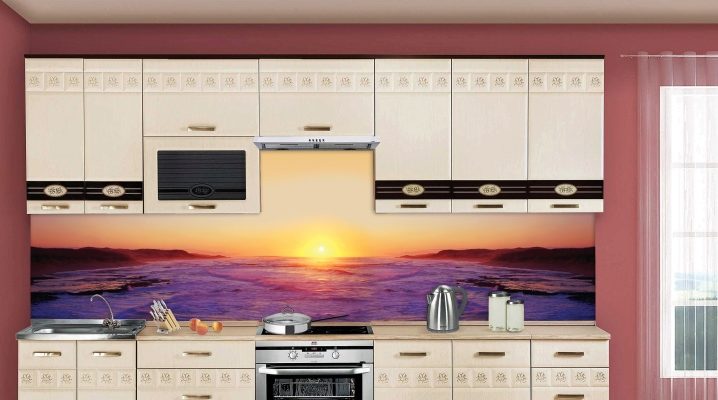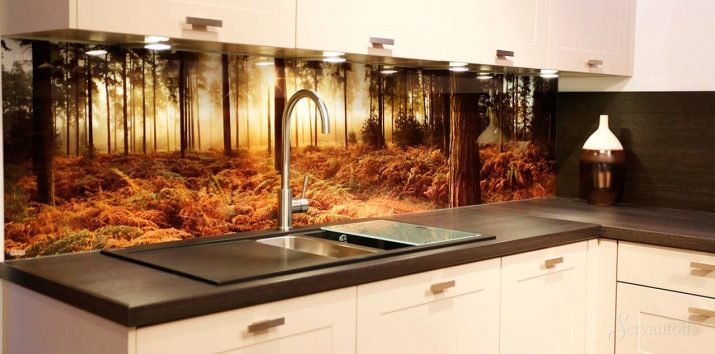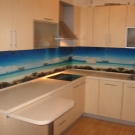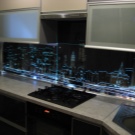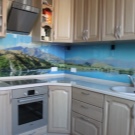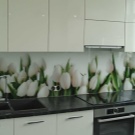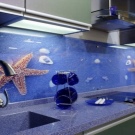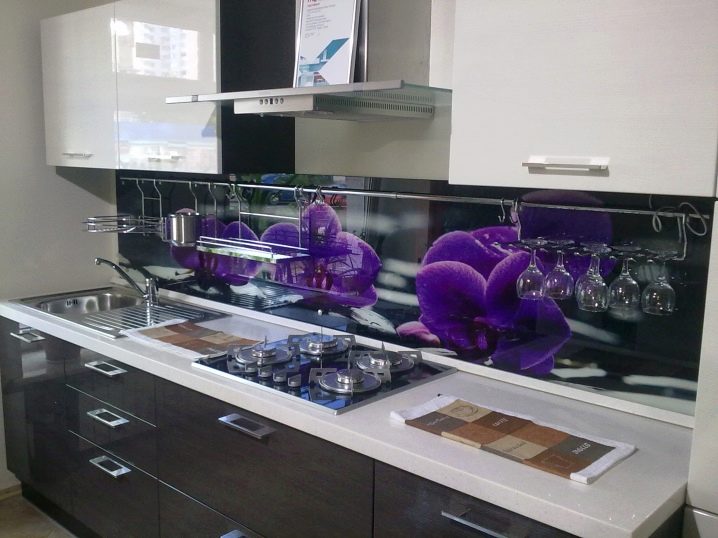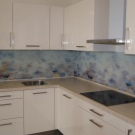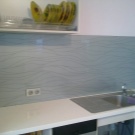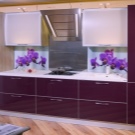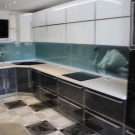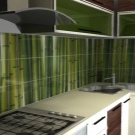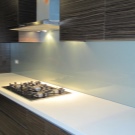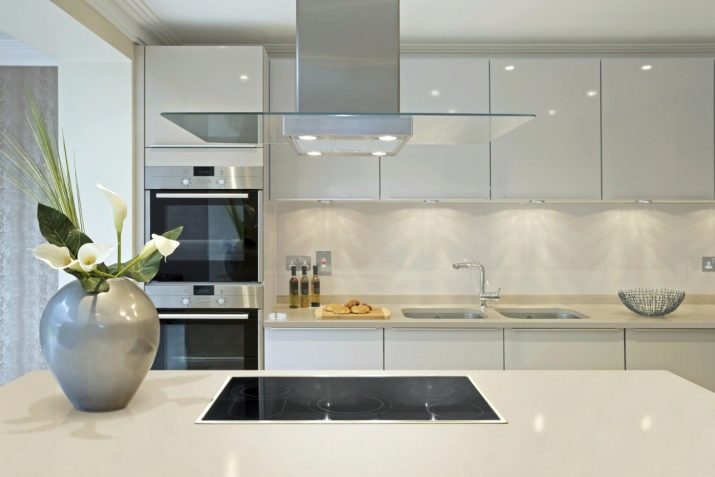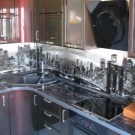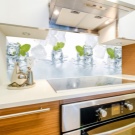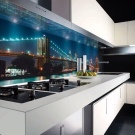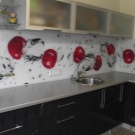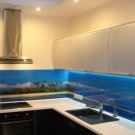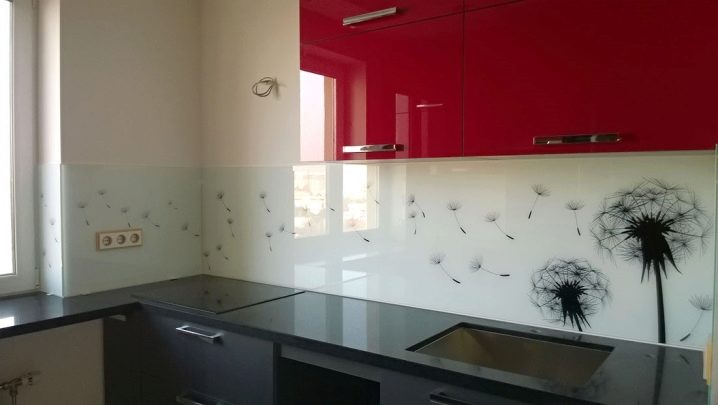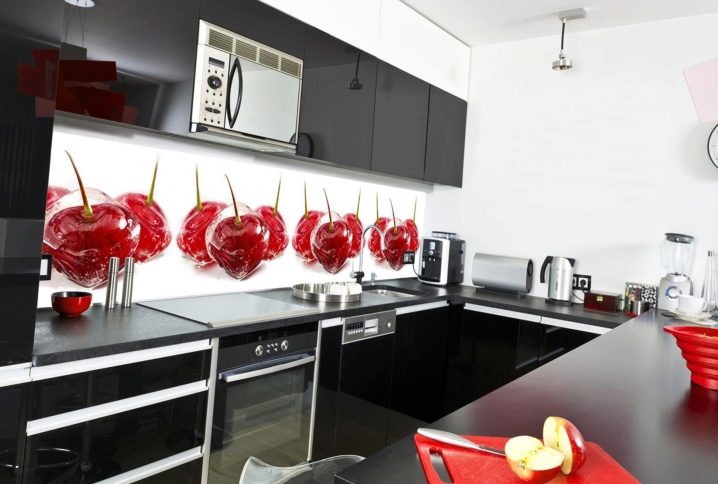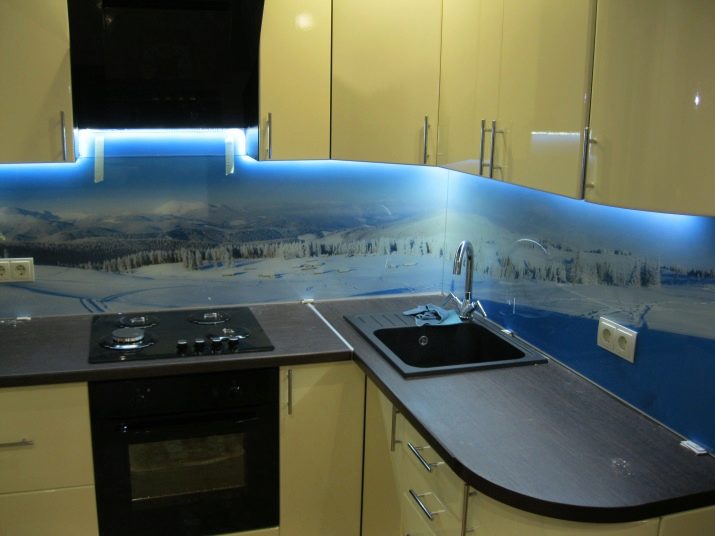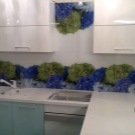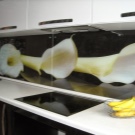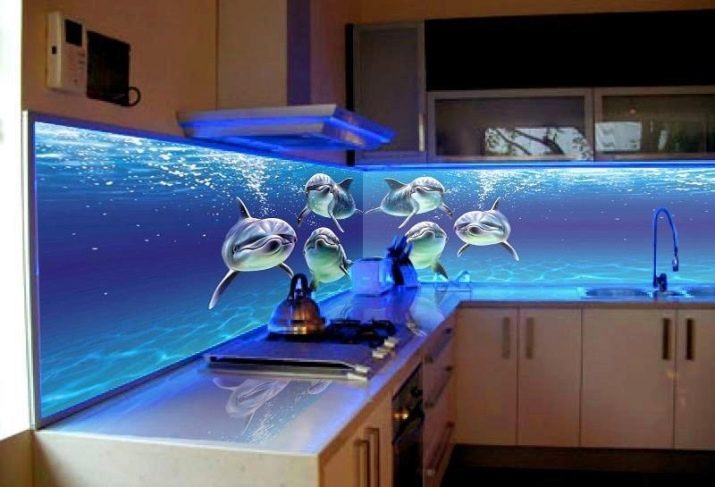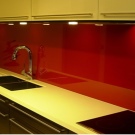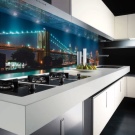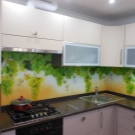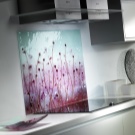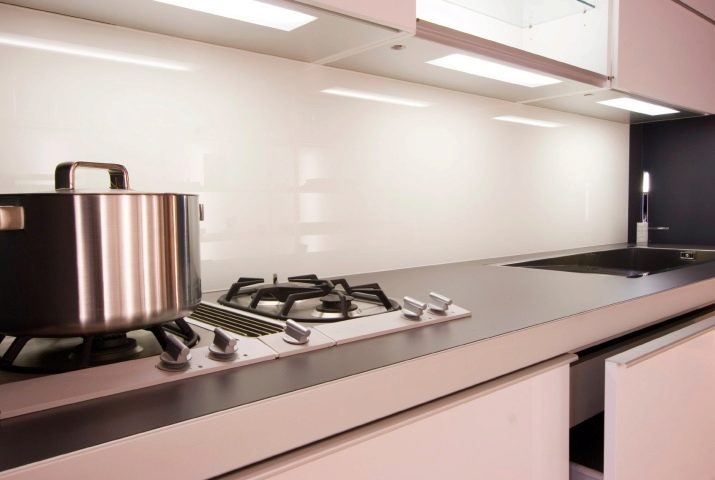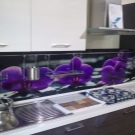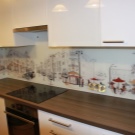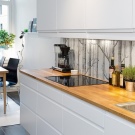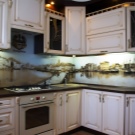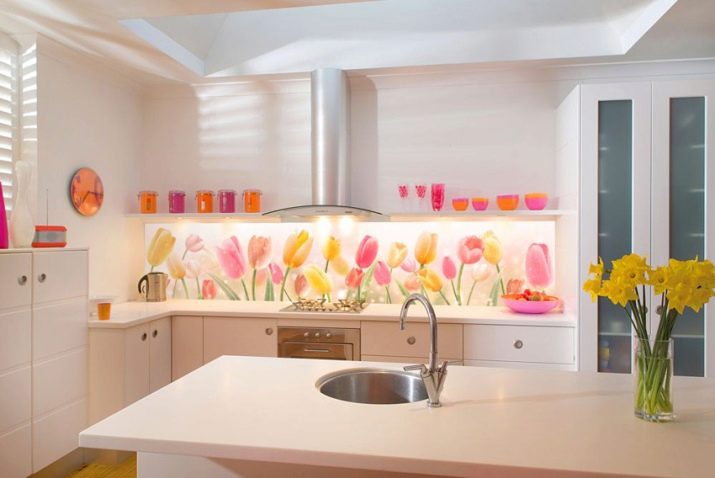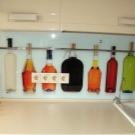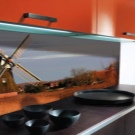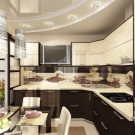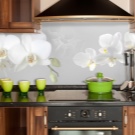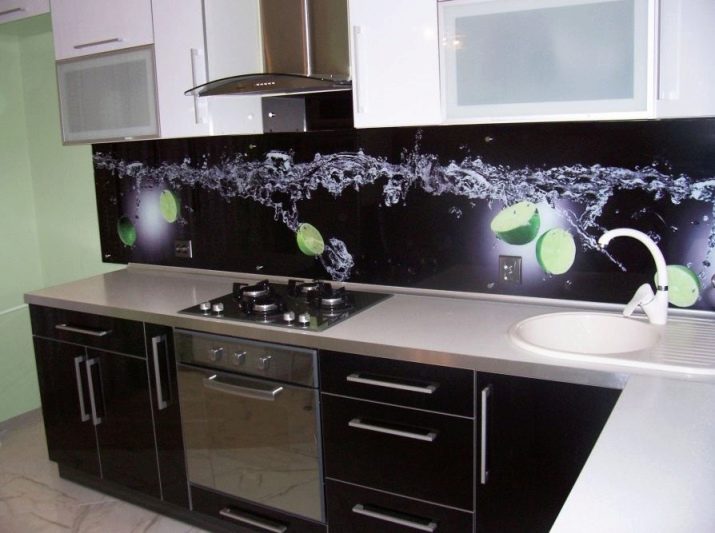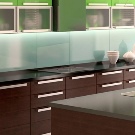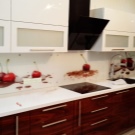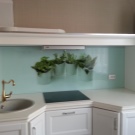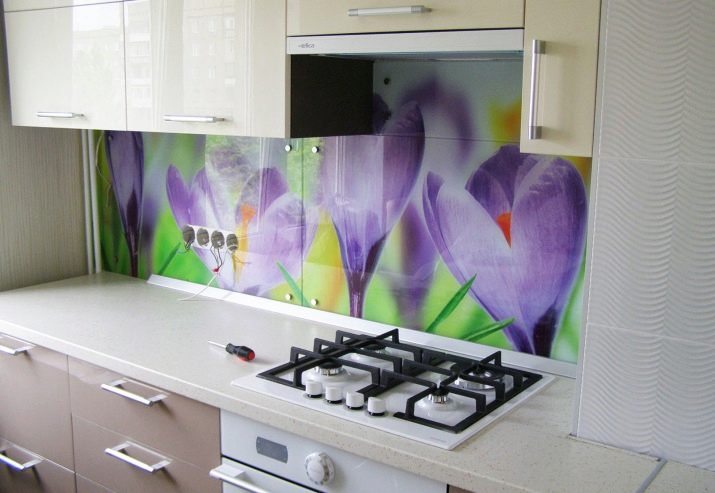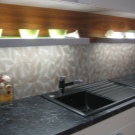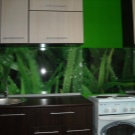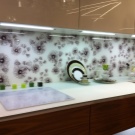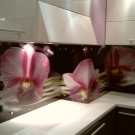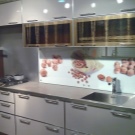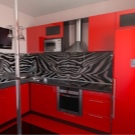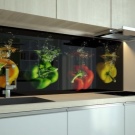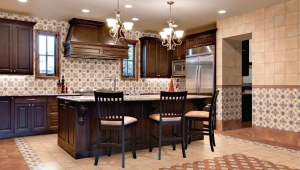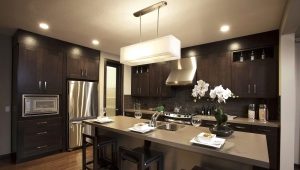Glass panels for the kitchen
In the kitchen, where food is prepared, it is difficult to maintain perfect cleanliness. Stains from splashing water, grease will remain on the walls, especially in the area of the stove, sink, table top of the cutting table. Therefore, for a long time, wall panels have been used to ensure the cleanliness of the kitchen. These panels are also called aprons. Most kitchens use ceramic tiles for this. Also for the manufacture of wall panels can be used stone, plastic, plexiglass, metal. But we will talk about kitchen glass panels - they are also called skinal.
Advantages and disadvantages
Glass is one of the most inert materials. It does not absorb odors, is resistant to chemicals, does not respond to moisture. Such characteristics are very well suited for use in the kitchen. Therefore, the last time glass panels for the kitchen are becoming increasingly popular.
To do this, they have many advantages:
- Absolutely environmentally friendly completely natural material.
- All contamination can be washed off with ordinary household products. But do not use hard brushes and scouring pads to avoid scratches. Still, it is glass, not diamond.
- The glass panel is not afraid of kitchen humidity, evaporation, odors.
- Such panels are made of one-piece glass sheet, which means there will not be butt joints, as in the case of tiled panels. It is in these places that dirt accumulates most often, and removing it from there is not an easy task.
- Glass - non-flammable material. There is a risk of cracks on it from high temperature, but it does not threaten the occurrence of a fire.
- Steklopaketi can be made as completely transparent, and with a picture. Transparent is convenient to use only as a protective, if your interior is already thought out, you do not want to complement it with anything, but you need to protect the walls from dirt.
- Skinales may have different colors, glossy or matte, with a variety of options for drawings. Diversity makes it possible to harmonize the interior of the kitchen with their help, to add additional accents to it.
- Typically, these wall aprons are fastened with screws, there is a small gap between the panel and the surface of the wall. So you can do without careful preparation of the wall, its shortcomings will be hidden by the panel.
- The installation of the panels itself is possible in a short time and is not associated with inconveniences, as in the case of laying ceramic tiles.
- Durability. Made of tempered glass, heat-resistant panels are not deformed, paints do not fade, so their service life will be determined only by your desire to replace them.
Having considered the advantages, it is impossible not to mention the disadvantages:
- It is recommended to install Skinali only after full placement and suspension of furniture. Dimensions for manufacturing must fully comply with the distance between the table top and the bottom of the wall cabinet. It is necessary to take into account all the necessary holes. This must be done especially carefully, because the fix will fail. Have to change completely.
- The cost of such a kitchen apron is quite high. Installing it yourself is impractical. The process requires professional skills, caution, because you have to work with glass.
- Definitely we can say that the existing shortcomings can not outweigh the advantages and the choice of glass panels to the kitchen will be a reasonable and reasonable decision.
Ways of drawing
If you decide to purchase a glass panel with a pattern, you need to know which methods of its application are most suitable for your requirements. The drawing is applied on the back side of the glass, so that any kind of it is completely protected from external influence. But the degree of security is different.
- Drawing is applied using sand blasting technology. Such a hinged panel looks delicately elegant, not striking, but ennobles the kitchen.
- Monochrome variants have excellent color fastness thanks to a special technique. The paint is applied to the surface and after that the glass is sent to harden. At the same time, the paint is soldered to the glass surface.
- Pasting of a film with a photographic image. From above such film is fixed with varnish or enamel. This is the most economical option, it looks no worse than all the others. Its main disadvantage is that the film will eventually lose its shape under the influence of temperature and moisture.
- Photo printing, that is, drawing the picture directly on the glass using the latest technology of UV printing. Drawing in such a way conveys the whole palette of colors and a variety of shades. Such images have excellent quality and high stability.
- Triplex consists of two layers of glass, between which the "baked" pattern. This method will be more expensive, but its reliability exceeds all other methods. An additional bonus of this method will be that if the glass is broken, then the fragments remain fixed on the film with the pattern.
- The creation of stained glass can be considered as an exclusive option. It will cost very expensive, but it will lose one of the main advantages of glass panels. Caring for such an apron is more difficult than for the tiles.
In any case, there is a choice in terms of cost and durability. It remains to determine the theme, color and size of the picture.
The choice of design solutions
The choice of patterns and colors is determined by many factors. The main thing is not to get carried away by bright, beautiful and spectacular drawings. It is good to remember about moderation, because the kitchen has to spend a lot of time,and too bright colors, large pattern, variegation can not only please the eye, but also cause irritation.
The basic methods of choice are based on the basic rules of design.
- For small kitchens you should not choose large drawings. A more successful option will be monochromatic skinali in the tone of the furniture, or a contrasting color.
- Spacious rooms allow you to experiment with color and pattern. The determining factor, in this case, will be the style of the kitchen, the color of the furniture.
- The bright monophonic apron can be harmoniously combined with most styles and colors of the kitchen.
- If the furniture has a glossy surface, the panel is better to choose matte to mute the glitter of the furniture.
- A universal combination, as usual, can be a combination of white and black.
- A classic kitchen will add elegance to an apron with dim urban landscapes. Good for this style and suit monochrome aprons.
- Perfectly fit in high-tech style. The combination of gloss of glass and metal will revive the restraint of this style.
- Country style can be complemented by different landscapes, images of spices, pastoral scenes.
- Pictures in the kitchen can be pictures of fruits, vegetables, beautiful dishes and delicious dishes.
- The original solution is to place on the apron photos of family members, children's drawings, memorable family photos.
- As a bold original version can be mirrored panels. Visually they expand the space. True, they have a significant drawback. Even small soiling is very clearly visible on the mirror surface.
- An important point in the design can play backlight panels. It can be solved in different colors. In addition, additional lighting in the work area will never be over.
Nevertheless, consultation with professional design will be very useful. After all, repair is not done on one day. The result should please for a long time, so it is better to initially try to avoid mistakes in the choice.
Mounting methods
Glass panels can be mounted in the following ways:
- On silicone glue or "liquid nails." In this case, the wall requires advance preparation. The preparation is similar for laying ceramic tiles. This method is economical.As a result, the mount is secure, without additional elements. Most of all this mount is suitable if the panel consists of more than one section. The downside to this method is the complexity of dismantling.
- Fastening on nails. Holes are made in the panel, which after fastening are closed with special plugs. The method is good because it does not require additional preparation of the wall, and dismantling is quite simple.
- Fastening on special metal holders. Holders are mounted on the wall. The panels are mounted on them. There are two ways to pass and hinged. Often used pass. For him on the panel install fasteners that flush the panel. When installing the panel mount will be noticeable. The hinged method allows you to hide fasteners. And the mount on the metal holders allows you to adjust the installation height.
How best to choose
Selection and installation of glass panels is made at the final stage of repair. The furniture should be installed, suspended, the places of sockets and fixtures should be determined.
The best option is to choose a well-established company for the manufacture of glass panels.Usually, in such firms the measurer service is provided free of charge. And for the manufacture of panels, the correct dimensions are very important, so this is better not to save.
Be sure to specify when choosing which glass is used for the panels. It must be hardened. This glass has a high strength, withstands even strong shocks, resistant to high temperatures, which is important when installing the panels next to the stove. Even if, due to some circumstances, the glass is broken, it does not give sharp fragments, but crumbles into small crumb.
When installing panels, it is desirable to be present in person. Properly designed panel should fit perfectly to the place of suspension. Any attempts at installation to squeeze or adjust the panel, it is necessary to stop, they can lead to cracks and chips. These damage may occur during operation, but it will be difficult to make a claim to the manufacturer.
In conclusion - a few words about the care of glass panels. It is simple. It is enough to use ordinary household tools to remove dirt and grease. It is undesirable to use abrasive materials and metal brushes.Do not forget that it is still glass and protect it from blows. Make sure that the gap between the panel and the wall is closed from the ingress of moisture there to avoid mold and mildew behind the panel.
